Bison FDPIR Guide Rate Increased as of July
1, 2018
 On July 1, 2018, a new Food Distribution Program on Indian Reservations (FDPIR) Monthly Distribution Guide Rate
by Household Size went into effect to include a change in bison
distribution. The inclusion of bison as a permanent USDA Food in FDPIR
began this fiscal year with a limit of 1 unit of bison per person per
month. Beginning July 1, 2018, the limit will be removed for at least the
next 6 months and households may select bison up to the maximum distribution
rate in the meat category, if they wish.
Friendly Reminder: If
you are an Indian Tribal Organization or State agency that administers FDPIR,
remember to update your Automated Inventory System and always use the new
posted Guide
Rate!
|
Shell Egg Pilot Expansion
 We continue to receive feedback from Indian Tribal
Organizations (ITO) participating in the shell egg pilot and to monitor and
evaluate how the pilot is working. Tribes use the Fresh Fruits and Vegetables Order/Receipt System
(FFAVORS) to place orders for shell eggs as part of their food package
benefit. The shell egg pilot replaces the powdered egg mix participants
receive each month with one dozen shell eggs. The shell eggs are delivered through the United States Department of Agriculture (USDA) Department
of Defense (DoD) Fresh Fruit and Vegetable Program (USDA DoD Fresh)
produce vendor.
Based on the positive feedback
from the 14 participating ITOs, we are able to expand the pilot to 18 additional ITOs: Acoma Food Distribution Program, Eight Northern
Indian Pueblos, Pueblo of Zuni, Five Sandoval Indian Pueblos, Keweenaw Bay
Indian Community, Little River Band of Ottawa Indians, Little Traverse Bay Band
of Odawa Indians, Sault Ste. Marie Tribe of Chippewa, Colville Confederated
Tribes, Lummi Indian Business Council, Makah Indian Tribe, Small Tribes of
Western Washington, South Puget Inter Tribal Planning Agency, Spokane Tribe of
Indians, Yakama Indian Nation, Kickapoo Tribe, Prairie Band of Potawatomi
Nation, and United Tribes of Kansas and Southeast Nebraska.
The addition of these
18 ITOs will increase participation in the pilot to a total of 32 ITOs,
which represents almost 31% of ITOs in FDPIR. The 18 ITOs were selected based on the
USDA DoD Fresh produce vendor, on-hand local inventory of powdered egg mix, and
the impact on the inventory of powdered egg mix at the National Multifood
Warehouses. We will continue to evaluate
the pilot and work collaboratively with DoD to improve and allow for future expansion
of the shell egg pilot.
|
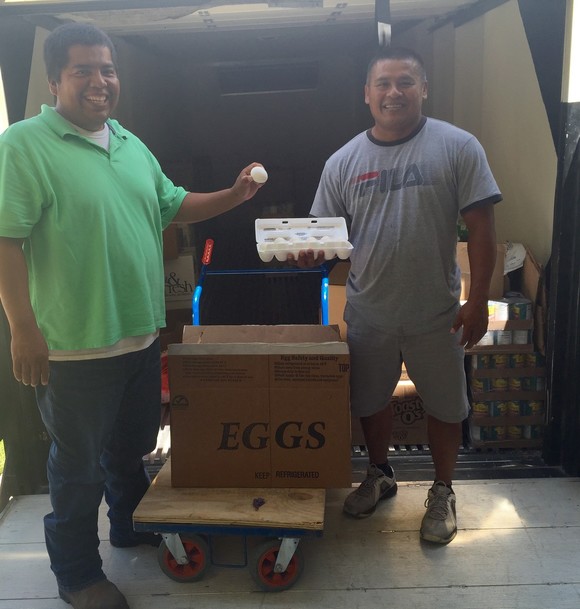 |
Mississippi Band of Choctaw Indians is one of the Indian Tribal Organizations participating in the shell egg pilot.
Refresh, Renew, Refocus – NAFDPIR Annual Conference
in Reno, Nevada
This year, more than 250 FDPIR food distribution staff descended
upon Reno, Nevada, to spend the week learning and networking. The gathering, held every
year, is the annual conference hosted by the National Association of Food
Distribution Programs on Indian Reservations (NAFDPIR). The conference
brings together program directors, certification staff, warehouse managers, and
tribal nutritionists from across the 102 Indian Tribal Organizations and 3
State agencies that currently administer FDPIR across the country. A
full week of training and break-out sessions on topics such as civil rights,
eligibility and certification of households in FDPIR, nutrition education, best
practices in budget, and the USDA DoD Fresh program, among other sessions, were
provided.
During the conference, a Tribal leaders consultation meeting
was also held with more than 15 Tribal leaders in attendance along with Food and Nutrition Service (FNS) Administrator Brandon Lipps and Deputy Administrator for Supplemental Nutrition and Safety Programs Diane Kriviski as the USDA consulting officials (pictured below). Government-to-government dialogue centered around Farm Bill provisions released
by the House and Senate Agricultural Committees, nutrition education, FDPIR
funding, and 638 Authority for Tribal governments to administer nutrition
programs.
Session Synopsis: Public Health Partnerships in Indian Country
This year during the NAFDPIR annual conference, staff from
the Centers for Disease Control (CDC) presented a session to highlight funding
opportunities and efforts to support and partner with Tribes to strengthen
their public health infrastructure and improve the health of their communities.
CDC supports Tribes in their public health efforts through funding, supporting
Tribes with surveillance and epidemiology and providing assistance to implement
evidence-based programs that integrate cultural practices. Projects funded by
CDC may address behavioral health, chronic diseases, and injury prevention.
CDC’s work with Tribal Epidemiology Centers helps Tribes access information
specific to their communities that can help inform decisions on how best to
focus time and resources on public health topics. In fiscal year 2017, CDC
provided approximately $44 million through grants and cooperative agreements to
Tribal governments and Tribal Epidemiology Centers.
Some of CDC’s specific funding opportunities include Good Health and
Wellness in Indian Country, Tribal Epidemiology
Centers, and Tribal
Practices for Wellness in Indian Country. Additional CDC investments
in Indian Country have been made through
other funding opportunities. Visit this page for more information.
Congratulations to the 15 Indian Tribal Organizations who received Fiscal Year 2018 Food Distribution Program on Indian Reservations Nutrition Education (FDPNE) Grants! USDA awarded the grants in July, totaling $991,950 across the 15 projects. The goal of the FDPNE grant is to enhance the nutrition knowledge of FDPIR participants and to foster positive lifestyle changes for eligible household members through nutrition education services. Examples of activities conducted by grantees
include nutrition education classes, cooking demonstrations, taste testing of
items available through FDPIR, and more!
View the 2018 grant recipients and project summaries here!
As part of a previous FDPNE grant, Lac du Flambeau in Wisconsin developed educational displays for FDPIR participants to read when they come to pick up their monthly food package.
Congratulations to Cherokee
Nation, Muscogee (Creek) Nation,
Mississippi Band of Choctaw Indians,
and Red Cliff Band of Lake Superior
Chippewa Indians for receiving a 2018 Farm to School Grant! USDA Food and Nutrition Service (FNS) Office of Community Food Systems
(OCFS) awards up to $5 million in competitive grants for entities, including
Indian Tribal Organizations, to plan and implement farm to school programs.
Cherokee Nation in
Tahlequah, Oklahoma, and Muscogee (Creek) Nation in
Okmulgee, Oklahoma, received Farm to School Planning grants to develop action
plans to increase access to farm-fresh, traditional foods, and learning
opportunities for tribal students.
Mississippi Band of Choctaw Indians in
Choctaw, Mississippi, and Red Cliff Band of
Lake Superior Chippewa Indians in Bayfield, Wisconsin, received
Farm to School Implementation grants to grow fruits and vegetables and expose
students to traditional indigenous foods while increasing economic
opportunities in their community.
Check out the 2018 Farm to School
List of Awardees to learn more about their farm to school
projects!
Farm to School
Grants, in addition to other USDA grants and loans, provide additional funding opportunities for Indian Tribal Organizations
interested in improving their food system, providing nutrition education, and
enhancing agricultural practices.
Oneida Tribe of Indians of Wisconsin, an FDPIR administering agency and previous Farm to School Grantee, received a Farm
to School Grant in 2015 to develop an aquaponics food production system. This
past winter, the tribe hosted a fish harvest event and
served fish tacos made with tilapia and lettuce harvested from their aquaponics
system. Event participants enjoyed the tacos and even learned how to scale fish! More than 100 heads of lettuce can be produced in a week and will be used on the
salad bar at Oneida Nation High School. Oneida Tribe is one of several Indian
Tribal Organizations that have used the Farm to School Grant Program to further
their food and agricultural programs.
Interested
in applying for a Farm to School Grant? The 2019 Farm to School Grant Program Request
for Applications (RFA) will be released this fall!
Catfish is the Newest Traditional Food Offered to FDPIR
The FDPIR Food Package Review Work Group selected catfish as the next traditional food to offer
through FDPIR. The product will be a 2-pound package with 8 unbreaded, skinless, boneless fillets that will each be approximately 4 ounces. We expect the product to be
available later this summer.
Did you know? National Catfish Day, June 25, was first celebrated in 1987 when President Ronald Reagan issued a Presidential Proclamation, after Congress passed a Joint Resolution calling for that designation. Catfish can be prepared in a variety of ways, from grilled to blackened to pan-fried with a cornmeal coating. Try this delicious recipe for Skillet Catfish from What's Cooking? USDA Mixing Bowl.
 |
|
Makes: 4 servings
Cook time: 20 minutes
Catfish
fillets are coated in a spicy cornmeal rub and pan-fried until browned to
perfection.
|
Ingredients
1/8 cup
cornmeal* (yellow or blue cornmeal!)
1 teaspoon
dried oregano
1/2 teaspoon
cayenne pepper
1 teaspoon
dried thyme
1 teaspoon
paprika
1/2 teaspoon
salt
1/2 teaspoon
black pepper
4 4-ounce
catfish fillets*
2 teaspoons
vegetable oil*
1 lemon (quartered)*
*USDA Food
Directions
1. Make the
spice rub. Put the cornmeal, oregano, cayenne pepper, thyme, paprika, salt and
pepper on a plate and combine well.
2.
Dredge both sides of the catfish in the spice mixture.
3. Put
the skillet on the stove and turn the heat to high.
4. When
the skillet is hot, add the oil. Add the fish and cook about 4 minutes on
each side, until browned and cooked throughout.
5.
Serve right away garnished with lemon wedges.
Source: USDA Center for Nutrition Policy and Promotion
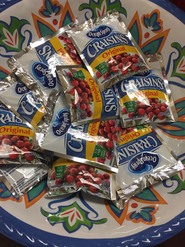 Dried Cranberries to Make FDPIR Debut this Fall!
The FDPIR Food Package Review Work Group recently voted to
introduce dried cranberries, on a limited basis, to the FDPIR food package
benefit. This year, purchasing raisins was not an option due to their poor harvest season. Thus, USDA presented the opportunity to purchase dried cranberries in the interim while the raisins are not available.
The dried cranberries will come in a 35 lb. case with 300 small
packs of dried cranberries. USDA plans to make the dried cranberries
available in the fall time-frame, and they will be offered as an additional item to all
FDPIR participants. Stay tuned for their arrival!
After participants have had a chance to taste the dried cranberries, the FDPIR Food Package Review Work Group will evaluate market conditions for all FDPIR dried fruit and feedback on the dried cranberries to determine which dried fruits will be offered in the future.
|
New Webinar Recordings: Best Practices when Receiving
Produce from the USDA DoD Fresh Program
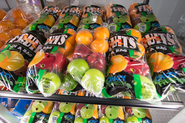 Indian Tribal Organizations (ITOs) that participate in FDPIR
are able to order fresh produce through the USDA Department of Defense (DoD)
Fresh Fruit and Vegetable Program as part of their monthly food package. The
USDA DoD Fresh Program, managed by USDA, offers a variety of American-grown produce, including seasonal items
such as asparagus, cherry tomatoes, avocado, kiwi, peaches, and many others!
USDA recently recorded two webinars that describe how this program works and provide best practices for inspecting and handling USDA DoD Fresh
produce.
If you have any questions, please feel free to reach out to us at USDAFoods@fns.usda.gov.
|
Indian Tribal Households – Verification with the CDIB
Card
As a friendly reminder, the Certificate of
Degree of Indian Blood, or CDIB card, is an acceptable form of verification for
proof of Tribal enrollment in FDPIR. For all Indian Tribal Households
living in approved near areas served by FDPIR or in the state of Oklahoma,
proof of Tribal enrollment is required for at least one member of the
household. The CDIB card may be used, but it is not required. Along
with the CDIB card, other forms of documentation are acceptable including an official
card, letter, or other documentation issued by an Indian Tribe which indicates
that the individual is a tribal member, or an official document from a Bureau
of Indian Affairs office or a Tribe/Nation which states the individual named is
a Federally-recognized member.
Powered Up for Year-Round Service!
 |
As you cross through mostly desert land, and just before
reaching the river that divides the state of Arizona and California, you come
upon a thriving food distribution program just around the bend. The
Colorado River Indian Tribes, who USDA staff recently had the opportunity to visit, operate the Food Distribution Program on Indian
Reservations serving a caseload of approximately 400 individuals. Most
impressive is their transformation to a grocery store distribution model for
their clients, weekly home-delivery stops, a well-accompanied kitchen to
conduct cooking demonstrations, and a new garden onsite, just outside their
front doors where clients of all ages gather to plant, sow, and harvest. Colorado River Indian Tribes also recently received an infrastructure grant from
FNS to replace their freezer and make electrical upgrades to their warehouse,
including a new generator. Although viewed as more “behind-the-scene”
improvements, the recent upgrades complete the program and, most importantly, contribute
to running a smooth distribution center for all their clients year-round.
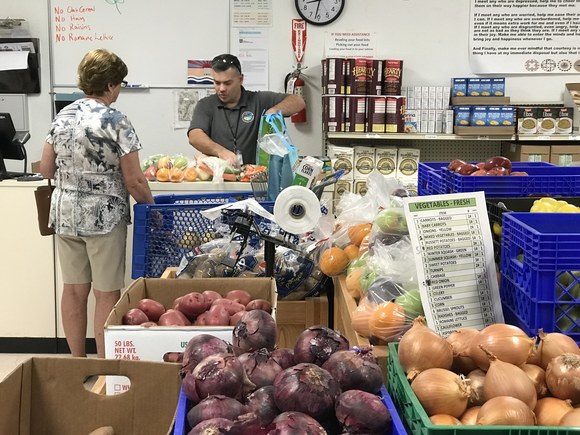 |
At the Heart of Spirit Lake FDPIR is
a New Demonstration Kitchen!
In 2015, Spirit Lake Tribe in North Dakota began renovations on the new home for its Food Distribution Program on Indian
Reservations, but with a different look: a grocery store set-up for
participants to select their food package items. The building, previously
used to house manufacturing equipment, was completely transformed to a new
environment filled with all the grocery store features. In 2016, the Tribe
officially opened its new doors, and in the same year, received additional
funding from FNS to design and construct a demonstration kitchen to
conduct nutrition education in the same building. The new kitchen, just
completed in May 2018, will be in full use starting this summer with FDPIR
youth attending cooking camp while they are out of school. Design
of a fall curriculum specifically for FDPIR clients is also currently
underway. Beginning in the fall, nutrition-related classes and activities
will be held throughout the month for FDPIR clients of all ages. Spirit Lake Tribe’s new kitchen really is the place to be!
 |
Retirement of Doug Friesen, AIS
Support
Doug Friesen, Information Technology Specialist at FNS,
retired on July 21, 2018. Since 1993, Doug managed the Automated
Inventory System (AIS). Over the past 25+ years, he has made many updates
to AIS to accommodate changes to the food package and to incorporate new
products while handling the day-to-day AIS help desk calls. We want to
thank Doug for all his years of service supporting FDPIR and wish him the best
in his retirement. For assistance with AIS during this time of
transition, please contact the WBSCM Service Desk
or call (877) 927-2648.
A New Look for the WBSCM Help Document Library
A new look was introduced to the WBSCM help document library in July
2018! Check the WBSCM portal
announcements for an overview and guidance for navigating the updated help
document library.
To access the WBSCM document library, navigate to Help -> Training -> and then
drill down through the different types of training materials, which include:
-
Work Instructions: step-by-step guidance for common transactions, organized by role and business function
-
Job Aids: reference documents for general help, working with reports, and more
-
Release Notes: summary of changes, the roles impacted, and links to related training materials impacted by monthly maintenance and system updates
In addition to changes in appearance, the following options for
working with training materials are available:
- If available, alternate formats are listed across the top of the screen. For example, a work instruction can also be viewed as a quick reference (without screenshots) or as a viewable/interactive simulation.
- By default, training materials display in the web browser in HTML format. To print or save a copy to your computer, use the Print PDF link or use the Download link to save an editable copy (usually Word).
As a reminder, materials in the library are regularly updated to
correspond to the current best practices, application enhancements, and system
requirements. If you are working with a saved or printed copy, check to see if
a newer version is available.
For additional assistance contact the WBSCM Service Desk or call
(877) 927-2648.
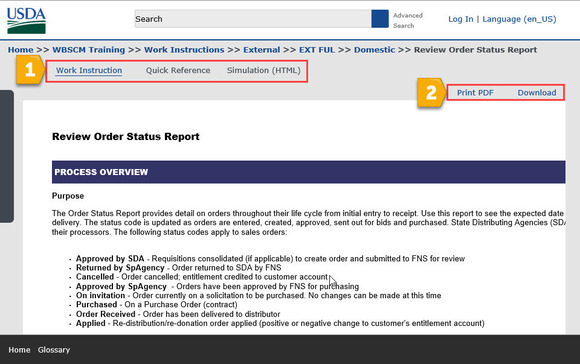
 1. Click here. Or you can go to the Food Distribution website and click on the red envelope on the row of social media icons on the top right of the page.
2. Enter your email address and click "Submit."
3.
Check the boxes to select your topic(s) of interest. For these
e-letters, scroll down to the Food Distribution category and click the
plus sign to the left of the check box to expand the list and view all
the topics. Select any of these topics to receive the general e-letter
plus the corresponding program-specific e-letter(s) of your choice:
*USDA Foods --> receive all "USDA Foods from Farm to Plate" e-letters
*Commodity Supplemental Food Program (CSFP) --> receive "Household Highlights"
*The Emergency Food Assistance Program (TEFAP) --> receive "Household Highlights"
*Food Distribution Program on Indian Reservations (FDPIR) --> receive "FDPIR Connection"
*Schools/Child Nutrition Commodity Programs --> receive "Spotlight on Schools"
4. Visit the subscriber preferences page any time you would like to review, add, or delete subscriptions. Questions? Contact USDAFoods@fns.usda.gov.
5. Share the e-letter and new subscriber link with interested colleagues and friends!
|
|